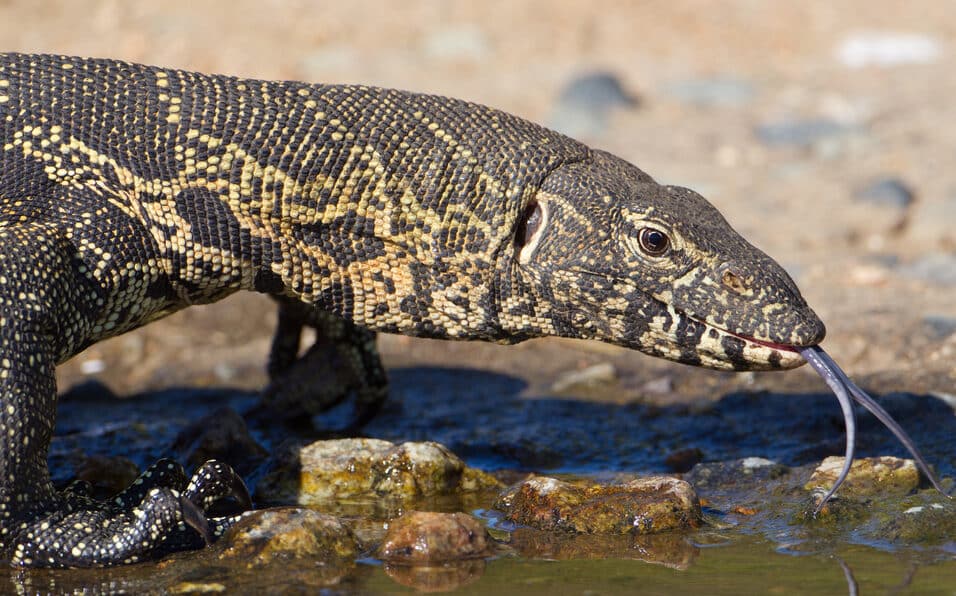5 Common LIZARDS found in Somalia! (ID GUIDE)
Do you want to learn about the different kinds of lizards in Somalia?

If so, you’ve come to the right place! In the article below, I have listed the lizards you can expect to see. For each species, you’ll find out how to identify that lizard correctly, along with pictures and interesting facts!
5 Lizards That Live IN Somalia:
#1. Nile Monitor
- Varanus niloticus

How to identify:
- Length: Between 47 – 86 inches (119 to 218 cm).
- Lifespan: Between 10 and 20 Years.
- Nile Monitors have prominent skin patterns; both males and females are grey/brown on top and have green/yellow barring on their tails. Both sexes have large, greenish-yellow spots on their backs, and their underside and throats are creamy-yellow.
Nile Monitors are one of the largest and most spectacular lizards to observe in Somalia.
Look for them roaming near a permanent water source near woodlands, scrubs, evergreen thickets, mangroves, and swamps. Nile Monitors feed on frogs, toads, rodents, small turtles, birds, eggs, insects, and fish.
Luckily, the Nile Monitor is a lizard, not a human; otherwise, society would frown upon its polygamous behavior. Both males and females mate with several other partners.
After mating, the female takes a break from the males and makes a suitable nest in termite borrows or digs a hole near water where she lays up to 60 eggs. The female is patient during the incubation process, which lasts six to nine months. The baby monitors dig their way to freedom, or the female digs them out, and after three to four years, they are ready to mate themselves.
#2. Speckle-lipped Mabuya
- Trachylepis maculilabris

How to identify:
- They have a brown back and a thin yellow rim surrounding their ear opening.
- Both sexes look similar.
The Speckle-lipped Mabuya, often called the Speckle-lipped Skink, is diurnal, meaning it is mostly active during the day. These lizards enjoy hot areas in Somalia and often bask on a rock or log under the intense sun.
The Speckle-lipped Mabuya prefer areas that are well protected from the elements and are often seen in buildings like houses, garages, and floor apartments. In nature, they find safety in thick foliage but often climb rocks to sun themselves or find a female or food.
#3. Flap-necked Chameleon
- Chamaeleo dilepis

How to identify:
- Males and females have a coloring that ranges from brown to yellow to green. Both sexes have between 1 and 3 light patches on their upper flanks and a light stripe on their lower sides.
- It is identified by its broad tail that starts at the base and a spur that grows behind each hind foot.
The Flap-necked Chameleon is a large lizard belonging to the Chamaeleonidae family, a common sight in Somalia. These unique lizards prefer moist or arid savannah, coastal forests, bushy grass, and woodlands, but it is known to venture into suburban and rural areas. They feed on various insects and invertebrates, like beetles and grasshoppers.
When it is time for breeding, the Flap-necked Chameleon male is no stranger to showing off his strength and masculinity by fighting other males to secure a suitable female. Winning the fight does not necessarily persuade the female, but it at least allows the male to approach her.
If the male is accepted, courtship with the female is brief and only lasts a few minutes. Mating lasts about an hour and is done in the trees’ safety.
#4. African Striped Skink
- Trachylepis striata

How to identify:
- Length: Up to 9.8 inches (24.9 cm).
- Lifespan: 18 years.
- Bronze-brownish with two full-length yellow stripes along the spine.
The African Striped Skink is easily identified by the two yellowish stripes along its spine, which is why it’s called a “Striped Skink.”
Grasslands and forests are home to this shy lizard that prefers to burrow underground to avoid predators. Sometimes, hiding from predators isn’t enough, and the Striped Skink will shed its tail to escape, but it grows back within a few months.
It doesn’t take long for baby Striped Skinks to grow up. After the youngsters take their first breath, it only takes 15 to 18 months to mature and reproduce.
#5. Variable Skink
- Trachylepis varia

How to identify:
- Blackish, pale brown, olive green, or red-brown back and sometimes has black spots. Look for a clear, white stripe down its backbone with a blueish-white belly.
- There is little difference between males and females except that females live longer.
The Variable Skink prefers dry savanna areas and grassland as their habitat in Somalia, where they spend their days climbing trees and rocks. They are great hunters and use barks, leaves, and stones to hide under, from which they pounce on their prey.
They waste no time reproducing because their life expectancy is less than two years. Once an individual is eight months old, they are ready to breed, and males set out to find a female.
Do you want to learn MORE about animals in Somalia?
Check out these ID Guides!
-
5 Dangerous Predators Found in Somalia
-
3 Types of Antelopes that live in Somalia
-
11 Common SPIDERS Found in Somalia! (w/Pics)
Which of these lizards in Somalia is your favorite?
Leave a comment below!

